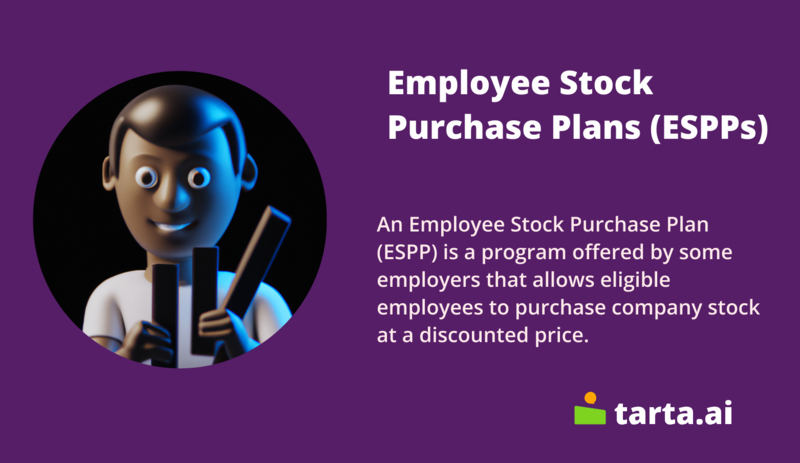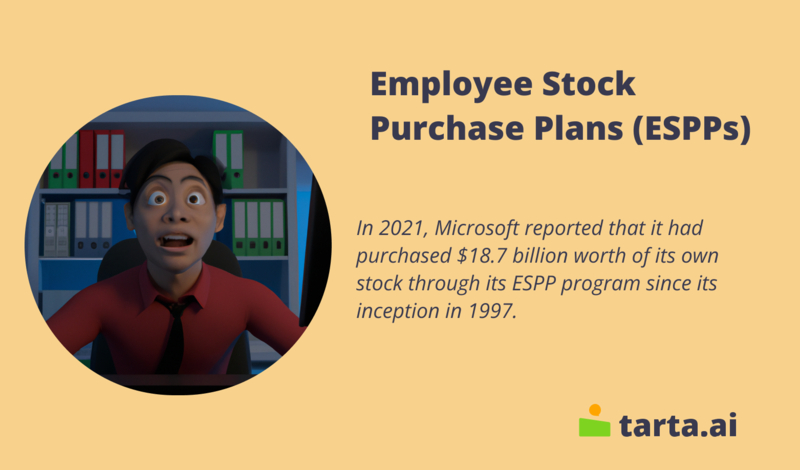How Do Employee Stock Purchase Plans (ESPPs) Work?
What is an ESPP?

Employees can typically contribute a portion of their paycheck to the plan, and the accumulated funds are used to purchase company stock on behalf of the employee at a predetermined price. The purchase price is often set at a discount from the current market price of the stock, providing employees with the opportunity to potentially earn a profit when they sell the shares at a later date. ESPPs can be a valuable employee benefit that provides an opportunity to build wealth and align employee interests with those of the company.
How do ESPPs work?
ESPPs typically work by allowing eligible employees to contribute a percentage of their paycheck to the plan over a specified offering period. At the end of the offering period, the accumulated funds are used to purchase shares of the company stock on behalf of the employee, typically at a discount to the market price of the stock. The discount can range from a few percentage points to as much as 15% or more, depending on the plan terms. The purchased shares are held in the employee's brokerage account and can be sold at any time, subject to any restrictions or holding periods imposed by the plan. ESPPs often have specific enrollment periods and contribution limits, so employees should review the plan documents carefully and consult with a financial advisor before participating.
Types of ESPPs
There are two main types of Employee Stock Purchase Plans (ESPPs): qualified and non-qualified plans. Here's a table summarizing the key differences between the two:
| Non-Qualified ESPPs | |
Eligibility | Available to all employees | Often limited to certain employees or groups |
Tax treatment | Potentially eligible for favorable tax treatment, subject to holding periods and other requirements | Not eligible for favorable tax treatment |
Discount limit | Discount limited to 15% or less of fair market value | No limit on discount allowed |
Contribution limit | Maximum contribution limit of $25,000 per year | No statutory limit on contributions |
Holding period | Shares must be held for at least 2 years after the offering period begins and 1 year after purchase | No holding period required |
Employer contribution | Employer contributions allowed | No employer contributions allowed |
Administrative burden | More administrative complexity and requirements | Less administrative complexity and requirements |
It's important to note that specific plan terms can vary widely and employees should review their plan documents carefully to understand the details and rules of their specific ESPP.
Benefits of ESPPs for Employees
Employee stock purchase plans (ESPPs) can be a valuable benefit for employees, providing an opportunity to purchase company stock at a discounted price and potentially build long-term wealth. Furthermore, ESPPs offer flexibility in selling shares, allowing employees to sell the stock at a time that is most advantageous for their personal financial situation.
So, ESPPs can provide several benefits for employees, including:
- Ability to purchase company stock at a discount: ESPPs allow employees to purchase company stock at a discounted price, which can potentially lead to significant gains if the stock price increases over time.
- Opportunity to build long-term wealth: By holding company stock over a longer period of time, employees have the potential to accumulate wealth as the company grows and the stock price appreciates.
- Alignment of interests with the company: When employees own company stock, their interests are more closely aligned with those of the company, potentially leading to greater job satisfaction and loyalty.
- Flexibility in selling shares: ESPPs provide employees with flexibility in selling their shares, allowing them to sell the stock at a time that is most advantageous for their personal financial situation.
- Favorable tax treatment: In some cases, ESPPs can provide favorable tax treatment, particularly for qualified plans that meet certain holding period requirements.
Overall, ESPPs can be a valuable employee benefit that provides an opportunity to build wealth and align employee interests with those of the company.
Tip
Plan for taxes: ESPPs can have tax implications, so it's important to understand the tax rules and plan accordingly. Depending on your country's tax laws, you may be subject to income tax, capital gains tax, or both.
Benefits of ESPPs for Employers
Employee stock purchase plans (ESPPs) can provide a range of benefits for employers, including increased employee engagement and retention, boosted employee stock ownership, potential for improved financial performance, cost-effectiveness, and tax benefits. By offering an ESPP, employers can provide a valuable benefit to employees while also potentially improving the company's financial outcomes.
So, ESPPs can also provide several benefits for employers, including:
- Increased employee engagement and retention: Offering an ESPP can help attract and retain top talent by providing a valuable benefit that aligns employee interests with those of the company.
- Boost in employee stock ownership: By offering an ESPP, employers can increase employee stock ownership, potentially leading to a more committed and loyal workforce.
- Potential for improved financial performance: Increased employee stock ownership can lead to a more engaged and motivated workforce, potentially resulting in improved financial performance for the company.
- Cost-effectiveness: Compared to other forms of employee compensation, such as salary increases or bonuses, ESPPs can be a cost-effective way to provide valuable benefits to employees.
- Tax benefits: Employers can potentially receive tax benefits by offering a qualified ESPP.
Overall, ESPPs can be a valuable benefit for both employees and employers, providing a way to align employee interests with those of the company and potentially leading to improved financial performance and retention of top talent.
NOTE
ESPPs can have complex tax implications for both employers and employees. Employers should consider working with a qualified tax advisor to ensure compliance with local tax laws and to understand the tax implications of offering an ESPP to employees.
Minuses of ESPPs
While ESPPs can provide a range of benefits for both employees and employers, there are also some potential drawbacks to consider, including:
- Limited diversification: ESPPs can create a concentration of investment risk in the employee's portfolio if they hold a significant amount of company stock.
- Market risk: As with any stock investment, there is always the risk of market fluctuations and a potential decline in stock value.
- Limited availability: ESPPs may not be available to all employees, or there may be restrictions on participation, such as a required minimum length of employment.
- Complexity: ESPPs can be complex, with different plan designs, eligibility requirements, and tax implications that can be confusing for employees.
- Lock-in periods: Some ESPPs may have lock-in periods, during which employees are unable to sell their shares, which can limit flexibility and liquidity.
It's important for employees to carefully consider the potential risks and drawbacks of ESPPs before participating, and for employers to communicate clearly and effectively about the plan's design, limitations, and potential risks.
Fact
A survey conducted by Charles Schwab found that employees who participate in ESPPs are more likely to feel financially secure and confident about their retirement savings compared to employees who do not participate in ESPPs.

Tips for maximizing the benefits of ESPPs
- Understand the plan: It's important to fully understand the plan's design, eligibility requirements, contribution limits, purchase discounts, and tax implications.
- Participate fully: Employees should aim to contribute the maximum allowed under the plan and take advantage of any purchase discounts offered.
- Diversify: To minimize concentration risk, employees should consider diversifying their investments by selling company stock purchased through the ESPP and investing the proceeds in other assets.
- Monitor and adjust: Employees should regularly monitor their ESPP investments and adjust their contributions as needed based on market conditions and their overall investment portfolio.
- Communicate effectively: Employers should communicate clearly and regularly with employees about the plan's benefits, limitations, and potential risks, and provide educational resources to help employees make informed decisions.
- There are two main types of ESPPs: Qualified ESPPs and Non-Qualified ESPPs.
- ESPPs provide a range of benefits for employees, including the potential for significant savings and the opportunity to share in the company's financial success.
- ESPPs can also benefit employers by boosting employee engagement and retention, increasing employee stock ownership, and potentially improving financial performance.
- However, there are also potential drawbacks to ESPPs, including limited diversification, market risk, and complexity.
- To maximize the benefits of an ESPP, both employees and employers should aim to fully understand the plan's design, limitations, and potential risks, communicate effectively, and regularly monitor and adjust their investments as needed.
FAQ
What is an ESPP?
An ESPP is an employee benefit plan that allows employees to purchase company stock at a discounted price.
How do ESPPs work?
Employees contribute a portion of their salary to the plan, which is used to purchase company stock at a discount. The purchased stock can be sold immediately or held for future gains.
What are the benefits of ESPPs for employees?
ESPPs provide employees with the opportunity to purchase company stock at a discount, potentially realizing significant savings and the opportunity to share in the company's financial success.
What are the benefits of ESPPs for employers?
ESPPs can help employers increase employee engagement and retention, encourage employee stock ownership, and potentially improve financial performance.
What are the potential drawbacks of ESPPs?
Potential drawbacks of ESPPs include limited diversification, market risk, and complexity. Additionally, the discount on the purchase price of company stock may be subject to taxation.